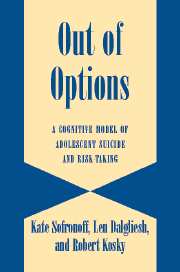Book contents
- Frontmatter
- Contents
- Preface
- Introduction
- 1 Adolescent Suicide: An Overview of the Epidemiology
- 2 Risk and Predisposing Factors in Adolescent Suicide
- 3 Emotional Problems and Adolescent Suicide
- 4 Adolescent Suicide: Cognitive Variables
- ADOLESCENT RISK-TAKING
- A MODEL OF SUICIDE AND RISK-TAKING
- AN EVALUATION OF THE S/RT MODEL
- IMPLICATIONS FOR TREATMENT
- References
- Index
3 - Emotional Problems and Adolescent Suicide
Published online by Cambridge University Press: 03 September 2009
- Frontmatter
- Contents
- Preface
- Introduction
- 1 Adolescent Suicide: An Overview of the Epidemiology
- 2 Risk and Predisposing Factors in Adolescent Suicide
- 3 Emotional Problems and Adolescent Suicide
- 4 Adolescent Suicide: Cognitive Variables
- ADOLESCENT RISK-TAKING
- A MODEL OF SUICIDE AND RISK-TAKING
- AN EVALUATION OF THE S/RT MODEL
- IMPLICATIONS FOR TREATMENT
- References
- Index
Summary
The literature now almost universally accepts that individuals who complete or attempt suicide are likely to be suffering from a mental disorder (Mazza & Reynolds, 2001). Lewinsohn et al. (1996) examined adolescents who had attempted suicide and found that 100% of the boys and 94% of the girls had a diagnosable mental disorder. This was a large prospective study using data collected from 1,709 high school students who were assessed on several occasions across a 10-year period from 1985. The researchers were, therefore, able to monitor psychiatric problems associated with suicide before the suicide attempt was made. In other studies, suicidal adolescents have not been prediagnosed and it is more difficult to be certain of the relationship between psychiatric disorders and suicide. The evidence that is available, however, is compelling.
Of 53 adolescent suicides in Finland, all but 3 were diagnosed with a psychiatric disorder (Marttunen, Aro, & Lonnqvist, 1992). Fifty-one percent were diagnosed with depressive disorders, 26% with alcohol abuse or dependence, 21% with adjustment disorder, 17% with conduct disorder or antisocial personality disorder, and 6% (three cases) with schizophrenia. Antisocial behavior during the year preceding the suicide was reported for 45% of the boys and 33% of the girls. In 78% of these cases, a diagnosis of alcohol abuse or depression was also present.
- Type
- Chapter
- Information
- Out of OptionsA Cognitive Model of Adolescent Suicide and Risk-Taking, pp. 31 - 42Publisher: Cambridge University PressPrint publication year: 2004



